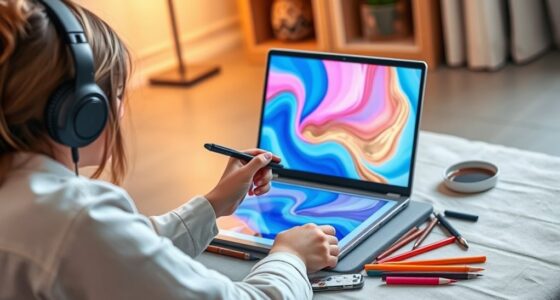Getting involved in community art projects can substantially boost your mental health and resilience. When you collaborate on murals or shared art, you build social connections that combat loneliness and foster a sense of belonging. Creating art allows you to express emotions and experience a sense of accomplishment. These projects also promote community pride and inclusivity, helping everyone feel valued. To discover how these initiatives can transform your life and your community, keep exploring these impactful initiatives.
Key Takeaways
- Community art fosters emotional expression, reducing stress and anxiety, which enhances overall mental resilience.
- Collaborative projects strengthen social bonds, creating supportive networks that help communities cope with challenges.
- Inclusive art spaces empower marginalized groups, promoting self-esteem and fostering a sense of belonging.
- Participating in art initiatives encourages community identity and collective pride, boosting mental well-being.
- Art-based activities improve social cohesion, empathy, and understanding, contributing to healthier, more resilient communities.

Have you ever wondered how art can improve mental health within communities? When you participate in community art projects, you tap into more than just creativity—you unlock powerful therapeutic benefits that can transform individual lives and strengthen collective well-being. Engaging in artistic activities allows people to express emotions that might otherwise stay bottled up, reducing stress and anxiety. The act of creating, whether through painting, sculpture, or mural work, provides a sense of accomplishment and purpose, which is essential for mental resilience. These therapeutic benefits aren’t just personal; they ripple through the community, fostering a shared sense of achievement and belonging. When you see your work appreciated by others, it boosts self-esteem and encourages ongoing participation, creating a positive feedback loop that nurtures mental health on a larger scale.
Community art projects boost mental resilience, foster belonging, and inspire ongoing participation through creative expression and shared achievement.
Beyond individual growth, community art projects are indispensable in building social cohesion. When you come together with neighbors, local artists, and volunteers, you forge connections that transcend daily routines and differences. Art becomes a universal language, allowing you to communicate and collaborate in ways that words sometimes can’t. This shared effort breaks down social barriers, encouraging trust and understanding among diverse groups. As you work side by side on murals or collaborative installations, you develop a sense of collective ownership and pride that strengthens community bonds. These relationships are essential for mental health, especially in areas facing social fragmentation or economic hardship. Knowing you’re part of a supportive network helps reduce feelings of loneliness and isolation, which are often linked to mental health struggles.
Community art projects also create inclusive spaces where everyone feels valued and heard. When you participate in these initiatives, you contribute to a collective narrative that reflects the community’s identity, struggles, and hopes. This sense of belonging can be incredibly healing, especially for marginalized or vulnerable populations. It affirms that your voice matters and that your experiences are part of a bigger story. Such inclusive projects foster empathy and compassion, key ingredients for resilient mental health. Furthermore, they serve as platforms for dialogue and understanding, helping to address social issues and promote mental well-being at a broader level. Additionally, engaging in these activities can enhance color accuracy, making the experience more immersive and emotionally resonant for participants and viewers alike.
In essence, community art projects do more than beautify spaces—they cultivate therapeutic benefits and social cohesion that empower communities to face challenges together. When you engage in these creative endeavors, you’re not just making art; you’re building resilience, forging connections, and contributing to a healthier, more connected society.
Frequently Asked Questions
How Do Community Art Projects Specifically Improve Mental Health?
Community art projects improve your mental health by providing therapeutic expression, allowing you to process emotions creatively. You can experience emotional release as you share your feelings through art, reducing stress and anxiety. Participating in these projects fosters social connections, building resilience. By engaging actively, you gain a sense of achievement and purpose, which boosts your overall well-being and helps you cope better with life’s challenges.
What Types of Art Activities Are Most Effective for Resilience?
Sure, finger-painting your stress away is obviously the cure for all mental woes. In reality, activities like collaborative murals or expressive writing are most effective for resilience, because they promote creative expression and emotional release. These activities help you process feelings, connect with others, and build confidence. So, grab your brushes or notebooks—because healing is just a splash of color or a few words away, and it’s surprisingly empowering.
How Can Communities With Limited Resources Start Art-Based Mental Health Initiatives?
You can start art-based mental health initiatives even with limited resources by focusing on volunteer engagement and low-cost activities. Seek local volunteers passionate about art and mental health to help run projects. Address funding challenges by partnering with community centers, schools, or local businesses for space and supplies. Use recycled materials and free online resources to keep costs down. Your enthusiasm and community support can create meaningful artistic spaces that foster resilience.
Are There Any Risks or Drawbacks Associated With Community Art Projects?
Yes, community art projects can have pitfalls, like mismanaging resources or not meeting participants’ needs, which can hinder success. You might also face community engagement challenges, such as low participation or differing expectations. These issues can lead to frustration or feelings of exclusion. To prevent this, plan carefully, communicate clearly, and involve community members early on to foster trust and ensure the project benefits everyone involved.
How Can Mental Health Professionals Best Collaborate With Artists?
You can best collaborate with artists by fostering strong interdisciplinary partnerships, ensuring open communication and shared goals. Leverage diverse funding strategies to support projects, making sure resources are sustainable. By actively engaging artists in planning and decision-making, you create a mutually respectful environment that enhances therapeutic outcomes. This collaboration helps you develop innovative approaches to mental health, blending artistic expression with clinical expertise for greater community impact.
Conclusion
By participating in community art projects, you not only express yourself creatively but also strengthen your mental resilience. These shared experiences foster connection, understanding, and healing—proving that art truly is a powerful tool for mental well-being. So, next time life feels overwhelming, ask yourself: could creating and connecting through art be your path to resilience? Remember, together, we can build stronger, more supportive communities through the power of creativity.









